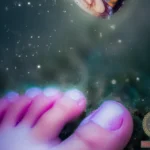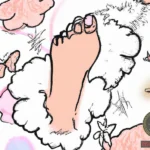Morton’s Toe, also known as Morton’s Foot, is a common foot alignment that has been causing people discomfort for centuries. In this article, we will explore the spiritual and dream meanings behind this common condition and how it affects our lives. We will also discuss how to identify and treat Morton’s Toe.
Dreams Meaning
Dreams of having Morton’s Toe
Dreams of having Morton’s Toe can indicate a feeling of being overlooked or disregarded by others. It can also symbolize a desire to stand out and be noticed. These dreams can also suggest a need for more balance in life, as Morton’s Toe can cause problems with walking and balance.
Dreams of having abnormally large feet
Dreams of having abnormally large feet can represent feelings of being overwhelmed or overwhelmed by the world around you. This type of dream can also suggest a need for more stability and security in life. These dreams can also indicate an inability to make decisions or take action.
Cultural Significance of Morton’s Toe
Morton’s toe has a long history as a sign of power and leadership. In some cultures, having a Morton’s toe was thought to indicate one was chosen by the gods to lead, while in other cultures it was seen as a sign of strength and fertility. In some cases, having Morton’s toe was thought to bring good luck, while in others it was seen as a sign of bad luck.
Historical Background of Morton’s Toe
The term “Morton’s toe” was coined by Dr. Dudley J. Morton, an American orthopedic surgeon, in the early 20th century. He observed that some individuals had a second toe that was longer than their big toe, and he believed that this was a sign of superior physical and mental abilities. He believed that those with a Morton’s toe were more likely to be successful in their chosen field.
Subscribe and Get a Free Dream Journal from Us
Religious Significance of Morton’s Toe
In some religions, Morton’s toe has been seen as a sign of divine favor. For example, in some branches of Christianity, having a Morton’s toe is believed to be a sign that the person has been chosen by God for a special purpose. In other religions, such as Hinduism and Buddhism, having a Morton’s toe is seen as a sign of good luck and fortune.
2 Pain Relief
Health Concerns
Morton’s toe is a common but often overlooked foot condition. The condition is characterized by a second toe that is longer than the great toe. While Morton’s toe is generally harmless, it can lead to a wide range of health complications, including pain and increased risk of injury.
Common Complications
The most common complication of Morton’s toe is pain. The condition can cause pain in the ball of the foot and the second toe, especially when walking or running. It can also lead to pain in the knees, hips, and lower back. Morton’s toe can also cause corns, calluses, and bunions to form on the second toe.
Pain Relief
Fortunately, there are a variety of treatments available for Morton’s toe. These include wearing proper shoes, avoiding high heels, and using toe spacers, orthotics, and toe pads. Exercises that target the calves, ankles, and toes can also provide relief from pain and discomfort. If these treatments are not effective, surgery may be recommended.
2 Treatment and Prevention
Treatment and prevention of Morton’s toe can be difficult, but there are some steps you can take to reduce the risk of developing the condition.
One treatment option is to wear shoes that are wide enough to accommodate the extra length of the second toe and have enough cushioning to reduce pressure on the ball of the foot. It is also important to avoid wearing high-heeled shoes, which can increase pressure on the forefoot. Orthotic shoe inserts may also be beneficial for providing extra cushioning and support.
For those with Morton’s toe who experience pain, anti-inflammatory medications such as ibuprofen and naproxen may help reduce inflammation and pain. Physical therapy and exercises to stretch and strengthen the muscles of the foot may also be recommended. If the pain is severe, surgery may be necessary to correct the toe deformity.
In terms of prevention, wearing properly fitting shoes is key. Shoes should have plenty of cushioning and a wide enough toe box to accommodate the length of the second toe. It is also important to avoid wearing high heels, which can put extra pressure on the forefoot. Regularly stretching and strengthening the muscles of the foot can help to reduce the risk of developing Morton’s toe.
Real-Life Examples of Morton’s Toe
Morton’s Toe is a common foot condition where the second toe is longer than the big toe or the first metatarsal bone. It is named after American orthopedic surgeon Dr. Dudley Joy Morton, who first described it in the 1920s. While it is usually a benign condition, it can cause a variety of problems and can be the source of chronic foot problems. Here are some real-life examples of Morton’s Toe:
- Pain and swelling in the ball of the foot
- Bunions and hammertoes
- Calluses and blisters on the soles of the feet
- Pain when walking or standing for long periods of time
- Pain when wearing certain types of shoes
- Plantar fasciitis or heel spur syndrome
- Misalignment of the toes and joints
- Ankle instability and foot fatigue
- Increased risk of stress fractures
Morton’s Toe can lead to chronic foot problems and can be difficult to diagnose. It is important to consult with a doctor or podiatrist if you experience any of the symptoms above. An accurate diagnosis is important in order to treat the condition effectively.
Emotional Impact
Having a Morton’s toe can have a significant emotional impact on someone’s life. It can lead to feelings of insecurity, embarrassment, and isolation. It can also be a source of ridicule and teasing, especially during childhood, which can have a lasting effect on the individual’s self-esteem.
| Feeling | Possible Impact |
|---|---|
| Insecurity | Lack of confidence in social situations |
| Embarrassment | Feelings of shame and humiliation about the condition |
| Isolation | Withdrawal from social activities due to fear of judgement |
| Ridicule and teasing | Negative self-image caused by bullying and teasing |
The emotional impact of having a Morton’s toe can be compounded by the physical discomfort and pain associated with the condition. This can lead to feelings of hopelessness and helplessness, as the individual may feel that there is nothing they can do to improve their condition.
In addition to the physical and emotional effects of having a Morton’s toe, the condition can have a financial impact as well. The cost of purchasing shoes that accommodate the condition can be expensive, and the individual may have to purchase multiple pairs of shoes in order to find a pair that is comfortable.
Although having a Morton’s toe can be difficult, it is important to remember that there are treatments available that can help to reduce the physical and emotional discomfort associated with the condition. Seeking professional help from a podiatrist or orthopedic specialist can help to improve the individual’s quality of life.
How to Cope
- Stretch and strengthen the muscles of the feet and lower legs.
- Take time to rest the feet.
- Wear shoes with a roomy toe box and a low heel.
- Choose insoles that provide arch support and cushioning.
- Opt for shoes with laces or straps that can be adjusted for a secure fit.
- Replace worn-out shoes.
- Avoid high-heeled shoes, which can worsen symptoms.
Conclusion
- Morton’s Toe is a common foot condition that affects the second toe.
- It can cause a number of uncomfortable symptoms, including pain, swelling, and difficulty walking.
- The condition is caused by a difference in the length of the first and second metatarsal bones in the foot.
- Morton’s Toe can be treated with exercises, orthotics, or surgery.
- It is important to consult with a medical professional if you are experiencing any of the symptoms of Morton’s Toe.
Frequently Asked Questions
1. What is Morton’s Toe and how is it different from other toe alignments?
Morton’s Toe, also known as Morton’s Foot, is an anatomical variation in which the second toe is longer than the big toe. This is the reverse of the usual toe alignment, where the big toe is the longest.
The difference between Morton’s Toe and other toe alignments can be seen in the following ways:
- The second toe is longer than the big toe in Morton’s Toe, while in other toe alignments the big toe is the longest.
- The second toe is placed lower than the big toe in Morton’s Toe, while in other toe alignments the big toe is usually placed higher.
- Morton’s Toe can cause the forefoot to become wider, while other toe alignments generally cause the forefoot to become narrower.
- Morton’s Toe can cause pain in the ball of the foot, while other toe alignments rarely cause this type of pain.
- Morton’s Toe can cause the arch of the foot to become higher and less flexible, while other toe alignments generally cause the arch of the foot to become lower and more flexible.
2. What spiritual and dream meanings are associated with Morton’s Toe?
Morton’s Toe has been associated with spiritual and dream meanings in various cultures and contexts throughout history. According to some, the presence of a Morton’s Toe is thought to be a sign of strength and power. It has also been believed to symbolize an individual’s ability to lead and be successful in their endeavors.
In some cultures, a Morton’s Toe is seen as a sign of good luck and fortune. It is believed that people with this type of toe have the ability to dream vividly and be successful in their pursuits.
In addition, it has been said that people with a Morton’s Toe have a special connection with nature and the spiritual realm. It is believed that they can easily access spiritual knowledge and gain insights into their dreams.
- A Morton’s Toe is seen as a sign of strength and power
- It is seen as a sign of good luck and fortune
- It is believed that people with a Morton’s Toe have the ability to dream vividly and be successful in their pursuits
- It is believed that they can easily access spiritual knowledge and gain insights into their dreams
3. Is it true that people with Morton’s Toe have a second toe that is longer than their big toe?
Yes, it is true that people with Morton’s Toe have a second toe that is longer than their big toe. This condition, also known as “Morton’s Foot”, is caused by a short first metatarsal bone in the foot. This short bone causes the second toe to be longer than the big toe.
The signs and symptoms of Morton’s Toe may include:
- Pain in the ball of the foot (metatarsalgia)
- Pain in the toes
- Corns and calluses on the second, third, or fourth toes
- Pain or discomfort when wearing certain types of shoes
- Reduced range of motion in the big toe
- High arch in the foot
If you suspect you may have Morton’s Toe, it is important to seek medical advice. Your doctor may recommend orthotic devices or special shoes to provide support and alleviate pain. In some cases, surgery may be recommended.
4. What can be done to improve the alignment of Morton’s Toe?
Morton’s Toe can cause a range of physical issues, including pain and discomfort in the feet and lower limbs. Fortunately, there are some simple steps you can take to improve the alignment of Morton’s Toe and reduce the associated pain.
- Wear well-fitting shoes that support the arch of the foot.
- Use arch supports, heel pads, and toe separators to reduce pressure on the toe.
- Perform exercises and stretches to strengthen the muscles in the feet and lower legs.
- Try wearing a night splint to keep the toes in the correct position while you sleep.
In some cases, a doctor may suggest wearing corrective shoes or orthotics to provide extra support and help the toes align correctly. If the condition is severe, surgery may be recommended to realign the bones in the toes.
If you think you may have Morton’s Toe, it is important to seek medical advice to ensure you receive the right treatment and care.
5. Are there any medical conditions associated with Morton’s Toe?
Morton’s Toe, also known as Morton’s Foot or Greek Foot, is an abnormality in the positioning of the big toe which can cause a variety of medical issues. While it is not a serious medical condition, there are several medical conditions associated with Morton’s Toe.
- Plantar Fasciitis – this is a condition where the plantar fascia (the tissue along the bottom of the foot) becomes inflamed and causes heel pain.
- Bunions – a bunion is an enlargement of the joint at the base of the big toe and can cause pain and discomfort when walking.
- Arthritis – Morton’s Toe can aggravate the big toe joint, leading to the development of arthritis.
- Hammertoe – this is a deformity of the toes caused by an imbalance in the muscles and tendons, which can lead to pain and discomfort when walking or wearing shoes.
- Flat Feet – having a Morton’s Toe can lead to an increase in the arch of the foot, which can cause flat feet.
It is important to note that having a Morton’s Toe does not necessarily mean that you will develop any of these medical conditions. However, if you do experience any of the above symptoms, it is important to seek medical advice.
Conclusion
It is clear that Morton’s Toe is more than just a physical condition, as it can have spiritual and dream interpretations. Those with Morton’s Toe can take comfort in knowing that they have a heightened intuition and are able to easily access and interpret their dreams. They can also use their intuition to make decisions and trust their gut feeling. It is important to remember that the spiritual and dream meanings behind Morton’s Toe should be taken with a grain of salt, as there can be a variety of interpretations and it is important to be mindful of personal biases. Ultimately, Morton’s Toe can be seen as a reminder to trust in yourself and your intuition.










